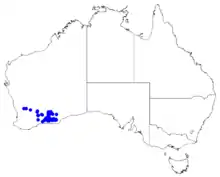Boronia fabianoides
Boronia fabianoides is a plant in the citrus family, Rutaceae and is endemic to the south-west of Western Australia. It is a compact shrub with many branches, simple, more or less cylindrical leaves and single white, pink or pale blue four-petalled flowers in the leaf axils.
| Boronia fabianoides | |
|---|---|
| Scientific classification | |
| Kingdom: | Plantae |
| Clade: | Tracheophytes |
| Clade: | Angiosperms |
| Clade: | Eudicots |
| Clade: | Rosids |
| Order: | Sapindales |
| Family: | Rutaceae |
| Genus: | Boronia |
| Species: | B. fabianoides |
| Binomial name | |
| Boronia fabianoides | |
 | |
| Occurrence data from Australasian Virtual Herbarium | |
Description
Boronia fabianoides is a compact, multi-branched shrub that grows to a height of 0.3–0.6 m (1–2 ft). The leaves are simple, more or less cylindrical 5–15 mm (0.2–0.6 in) long with a channel on the upper surface and often bunched. The flowers are white, pink or pale blue and are borne singly in leaf axils on a fleshy pedicel 1–2 mm (0.04–0.08 in) long. The four sepals are fleshy, narrow triangular to egg-shaped and 1–3 mm (0.039–0.12 in) long. The four petals are broadly elliptic, 3–7 mm (0.1–0.3 in) long and thickened- glandular along the mid-line. The eight stamens are hairy.[2][3]
Taxonomy and naming
This boronia was first formally described in 1904 by Ludwig Diels who gave it the name Eriostemon fabianoides and published the description in Botanische Jahrbücher für Systematik, Pflanzengeschichte und Pflanzengeographie.[4][5] In 1970 Paul G. Wilson changed the name to Boronia fabianoides[6][7] and in 1998 he described two subspecies:[8]
Distribution and habitat
Subspecies fabianoides grows in eucalypt woodland between Norseman and the Esperance but subspecies rosea grows on hillslopes, around granite rocks and undulating plains between Lake King and the Fraser Range east of Norseman.[8]
Conservation
Both subspecies of B. fabianoides are classified as "not threatened" by the Western Australian Government Department of Parks and Wildlife.[9][10]
References
- "Boronia fabianoides". Australian Plant Census. Retrieved 11 March 2019.
- Duretto, Marco F.; Wilson, Paul G.; Ladiges, Yvonne Y. "Boronia fabianodes". Australian Biological Resources Study, Department of the Environment and Energy, Canberra. Retrieved 11 March 2019.
- Corrick, Margaret G.; Fuhrer, Bruce A. (2009). Wildflowers of Souther Western Australia. Dural: Rosenburg Publishing. p. 191. ISBN 9781877058844.
- "Eriostemon fabianoides". APNI. Retrieved 11 March 2019.
- Diels, Ludwig (1904). "Fragmenta Phytographiae Australiae occidentalis. Beitrage zur Kenntnis der Pflanzen Westaustraliens, ihrer Verbreitung und ihrer Lebensverhaltnisse". Botanische Jahrbücher für Systematik, Pflanzengeschichte und Pflanzengeographie. 35 (2–3): 322. Retrieved 11 March 2019.
- "Boronia fabianoides". APNI. Retrieved 11 March 2019.
- Wilson, Paul G. (1970). "A Taxonomic Revision of the Genera Crowea, Eriostemon and Phebalium (Rutaceae)". Nuytsia. 1 (1): 119. Retrieved 11 March 2019.
- Wilson, Paul G. (1998). "New names and new taxa in the genus Boronia(Myrtaceae) from Western Australia, with notes on seed characters". Nuytsia. 12 (1): 150. Retrieved 12 March 2019.
- "Boronia fabianoides subsp. fabianoides". FloraBase. Western Australian Government Department of Parks and Wildlife.
- "Boronia fabianoides subsp. rosea". FloraBase. Western Australian Government Department of Parks and Wildlife.